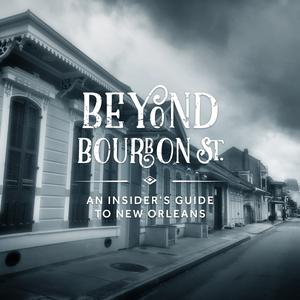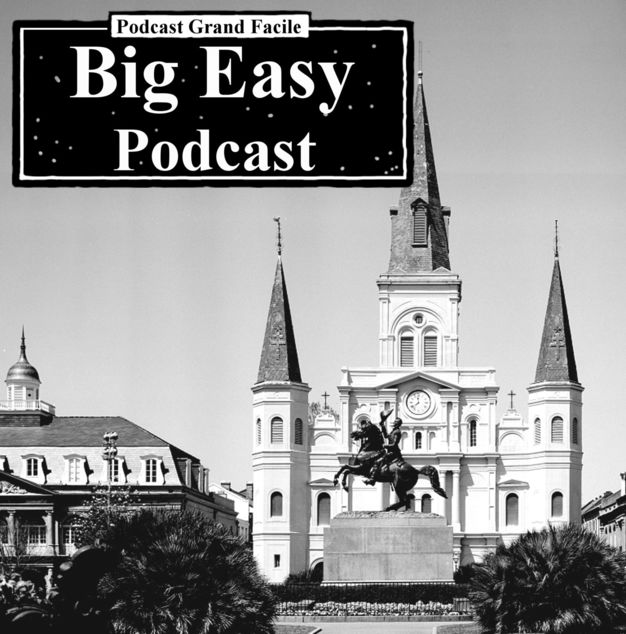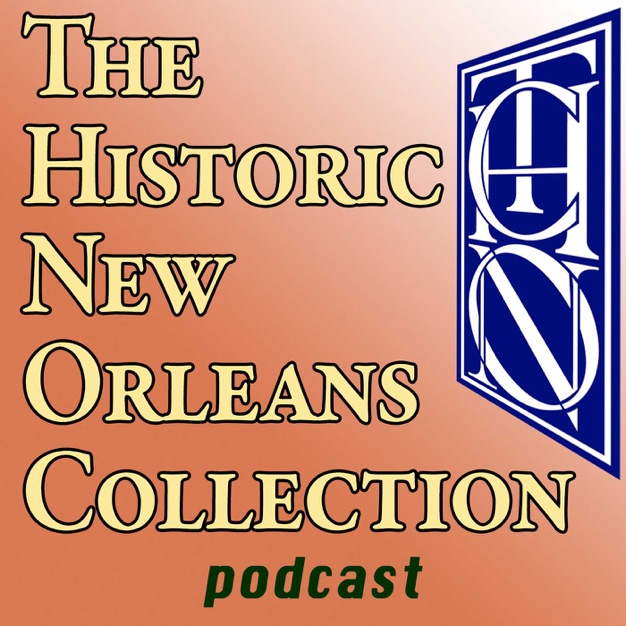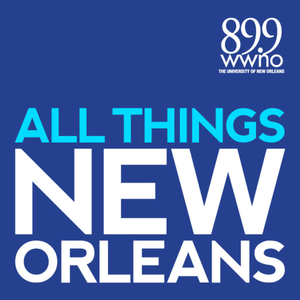
NOLA History Guy
NOLA History Guy
New Orleans History, Nostalgia, and Fun!
- 43 minutes 1 secondPodcast 45 – The Arsenal on St. Peter by Boyd Cruise
Podcast 45 features a Boyd Cruise painting of The Arsenal building on St. Peter Street.

“The Arsenal” by Boyd Cruise
Alvik Boyd Cruise painted the Old State Armory, better known as The Arsenal, in 1941. Located directly behind the Cabildo, the city built the Arsenal in 1839. Cruise visualizes it here in the 1850s.
The Pod
New Orleans Military
The city’s armory was naturally a focal point for troops stationed in the city. Like most of his paintings, Cruise created an active street scene on St. Peter Street. We see two Cavalrymen on the left. The rider of the brown horse is a trooper, possibly an aide or batman to the officer on the white horse. In the doorway stand two soldiers, possibly artillerymen, since the Arsenal stored cannon along with small arms.
The soldier in red is likely a member of a local militia company. Since they were raised by the city and/or state, they didn’t have to follow army uniform regulations. These units often chose colors reflecting their French/Spanish roots. On the right, another soldier is in conversation with a woman. He wears a uniform similar to the men in the doorway. He’s doffed his shako to talk to the lady.
The Story
What are they talking about? I just love these #writingprompts Cruise offers. I wonder if he had something in mind, or if he just left these as blank pages for us to fill in later. What do you think? Comment here or on Facebook or Bluesky and tell us the story. We need to start some literary zine or something to draw ideas out of y’all.
As in many of his paintings, Cruise includes a child in the scene. This provides scale, and it also shows what kids were u to, antebellum. This black boy is likely enslaved, as he would be in school if he was free. Therefore, an enslaved boy has a lot of unstructured time. While his mom likely works for a household nearby. He’s out on the street to get out of her way, and maybe promote a hustle or two.

So, here’s a zoom-in on the street activity
Shout-outs
The post Podcast 45 – The Arsenal on St. Peter by Boyd Cruise appeared first on Edward Branley - The NOLA History Guy.
18 January 2025, 12:01 am - 47 minutes 59 secondsPodcast 44 – “The Levee” by Boyd Cruise
Podcast 44 features a Boyd Cruise painting of “The Levee” on the Mississippi River.

“The Levee” by Boyd Cruise
Alvik Boyd Cruise painted this exciting and busy waterfront scene in 1959. While THNOC dates the setting as 1859 (probably a typo from the actual date the artist created it), the inclusion of the Steamboat Fashion puts it at 1865-1866. While so many of Cruise’s paintings focus on particular homes and buildings, this one casts a wider net. Instead of capturing the feel of a particular building in time for a Historic American Building Survey, the artist re-creates the activity in the port, mid-19th century.
The Pod
Post-bellum
This painting shows activity in the second-largest port in the US in the 1800s. What’s particularly interesting is that Cruise details the port after the Civil War. When we think of 1865, images of the destruction and horrors of war often come to mind. Many forget that the direct participation of New Orleans in the war ended in 1862. By 1865, the Mississippi was open to riverboat activity from Vicksburg to New Orleans. With the war over, investors contracted shipbuilders to get more boats in the water that would transport cotton from plantations to the port for export.
Cotton
Bales of cotton stand on the dock. They await loading onto ocean-going ships for export. These steamboats brought “raw” cotton from plantations to New Orleans. Those big bales were too bulky for export. So, cotton factors purchased the bales from ship captains. They transported the cotton to industrial pressing plants. Think of a trash compactor in a home kitchen, but on a much larger scale. They returned the compressed bales seen in the painting to the dock. Ocean-going vessels transported those bales up the Atlantic coast and to Europe.
Steamboat Fashion
Frank Leslie’s Illustrated Newspaper detailed the horrific fire onboard the Fashion, just above Baton Rouge, December 27, 1866.
The post Podcast 44 – “The Levee” by Boyd Cruise appeared first on Edward Branley - The NOLA History Guy.
10 January 2025, 1:53 pm - 36 minutes 9 secondsNOLA History Guy Podcast 43 - LaPretre Mansion on Dauphine Street (Boyd Cruise Series #1)
Podcast 43 features a Boyd Cruise painting of Le Pretre Mansion on Dauphine Street.

NOLA History Guy Podcast 2025
The pod returns! We’re organizing a bit more this year. The pod now features four-episode series. The paintings of artist Boyd Cruise kick this off. Episode 43 discusses Cruise’s painting of La Pretre Mansion.
Le Pretre Mansion on Dauphine Street
The magnificent house at the corner of Dauphine Street and Orleans Avenue in the Vieux Carré is commonly known as the Le Prete Mansion. It’s also known as the Gardette-La Prete House, reflecting the historic marker on the building:
Erected 1836 for
Joseph Coulon Gardette, Dentist
Frederic Roy, Builder
The cast iron galleries were added by
Jean Baptiste Le Pretre, Planter
who purchased the house in 1839 and
owned it until 1878.While the Historic American Building Survey (HABS) – LA-53, contains detailed photographs and drawings of the house, it was artist Boyd Cruise who captured the feel of the corner, ante-bellum. Cruise painted the house in 1941. The work is typical of many from Cruise. He took the detailed HABS photos and visualized what the buildings looked like in the mid-ninteenth century. Here’s the caption for the work from THNOC:
Facade view of Le Pretre Mansion on Dauphine Street in the Vieux Carre. It was built in 1836 for J. C. Gardette by Frederick Roy. Pedestrians and a horse drawn carriage are visible in this mid-nineteenth-century depiction.
Look at the activity in the painting! It’s not just a writing prompt, but multiple ideas. Who’s the woman looking out from the third-floor gallery? What are the couple on the second floor discussing? Is the woman further down that gallery listening in on them, or watching something in the street? Is that the lady of the house in the doorway, greeting a visitor in the carriage? The coachman assists the rider out of the carriage while one of the household women (likely enslaved) watches from the sidewalk. Pedestrians pass by on the left-hand side of the scene. Another couple walks past the house on the right. A small boy takes in the activity while standing in the street. He likely waited to cross as the work wagon on the left passed him by.

Cruise’s attention to detail and fashion is exquisite. Such a talent, to turning photos and architectural drawings into human actions and movements.
Sultans and Ghosts
The La Pretre Mansion ranks high on the “ghost tour” circuit, where it’s known as the “Sultan’s Palace.” We’re not big on these stories, but if you are, you’ll enjoy photographer/writer Michael Democker’s piece for Very Local on the house.
The post Podcast 43 – Le Pretre Mansion on Dauphine Street appeared first on Edward Branley - The NOLA History Guy.
3 January 2025, 2:07 pm - 59 minutes 58 secondsPodcast 41 – Krewe of Proteus
We’re talking about the Krewe of Proteus, a Lundi Gras tradition.

Mobilius in Mobili photo
Podcast 41 – Krewe of Proteus.
Happy Lundi Gras! The Krewe of Proteus first rolled the streets of New Orleans in 1882. While they’re not the oldest Carnival organization, they’re the oldest that still parades. Here’s the video of the history of Proteus:
Heere’s the PDF of the presentation.
The Krewe that came back

Of the three krewes that withdrew from parading in 1992 (Comus, Momus, and Proteus), the Krewe of Proteus returned to the streets in 2000. As we discuss in the pod, Proteus had stronger reasons to return to public view. While the other two krewes hold seniority, Proteus held visibility. Momus paraded on the Thursday before Mardi Gras. That spot now belongs to the Knights of Babylon. Babylon traditionally paraded on Wednesday, and moved up in the pecking order. Or did they? After all, Thursday night now belongs to the Krewe of Muses, one of the super-krewes.
Comus paraded on Mardi Gras night. When they began in 1857, the Mystick Krewe were the only parade in town. Over a century, however, other krewes out-shone the oldest organization. By the 1980s, the Comus parade was essentially glorified transportation to their ball. Worn out from a day of marching clubs, Zulu, Rex, and the truck floats, the majority of Uptown carnival-goers gave up before dusk.

The Comus ball, held for decades on one side of the Municipal Auditorium on Mardi Gras, is still the Big Deal in “society” circles. Even Rex defers to Comus by leaving his own ball and closing out the season with Comus. So, the members of the Mystick Krewe didn’t lose much sleep over not returning to parading. That’s ironic, of course, since they eventually did prevail in court over the city.
Proteus, on the other hand, had the most prominent position of the three. Even before “Lundi Gras” was an event in itself, they embraced the anticipation and excitement of the evening, leading into the big day.
The post Podcast 41 – Krewe of Proteus appeared first on Edward Branley - The NOLA History Guy.
12 February 2024, 9:44 pm - Podcast 40 – New Orleans King Cakes
New Orleans King Cakes date back centuries, with exciting times ahead.

King Cake from Adrian’s Bakery in Gentilly
New Orleans King Cakes
From Twelfth Night to the start of parades, the public face of Carnival is the King Cake. Let’s run down some of the background on this wonderful tradition. Note that this is background, history. Your preferred modern king cake is up to you!
Here’s the YouTube version of the pod. As we’ve mentioned previously, I record the pod using Zoom. It’s wonderful, because Zoom generates audio and video. I like to think the audio version of the pod is more fun, but what the heck.
Show notes
Here’s the PDF of the images, so you can follow along with the audio.

The Clay Monument. On 31-December-1869, the Twelfth Night Revelers invited New Orleans to see them pass by the Clay Monument on January 6, 1870. As mentioned in the pod, we’re going to have to do a full episode on the monument’s history. The reason TNR used this landmark as a gathering point was its size. The original monument dominated the three-way corner of Canal, Royal, and St. Charles Streets. Can you imagine this beast of a monument in the middle of modern Canal Street? Perfect place to tell the city, “come see us.” This is a Theodore Lilienthal photo.

Restaurant Antoine: New Orleans’ oldest restaurant, on St. Louis Street, between Royal and Bourbon. Several of the dining rooms at the restaurant are named after Carnival organizations. This is the Twelfth Night Revelers room.
Bakeries
King Cake Hub
King Cake Hub, located at Zony Mash Brewery, 1464 S. Broad, is a great option for one-stop king cake shopping. You’re looking to have a king cake tasting at the house, or at work? No better way to get a sampling of different styles than here.
CORRECTION: I said North Broad for the location of King Cake Hub at Zony Mash when it should be SOUTH Broad!
The post Podcast 40 – New Orleans King Cakes appeared first on Edward Branley - The NOLA History Guy.
24 January 2024, 3:05 pm - Podcast 39 – A Carnival Primer
A Carnival Primer for everyone.

Comus Parade, 1858
Podcast 39 – A Carnival Primer
When I’m asked to speak to a group that’s come to town for a convention, meeting, etc., they often ask for a talk on a Carnival-related subject. I’ve expanded this into a Carnival Primer that traces the celebration back to its medieval European roots, up to modern times. Now it’s a podcast and “cornerstone” content.
YouTube
As y’all know, I record the podcasts using Zoom. I’m also going back through talks I’ve given re-recording them via Zoom. That way, y’all can clearly see the images used for that presentation. In the case of this Carnival Primer, the talk is a good bit longer than something I’d do for a live group. They can’t pause and run to get another glass of wine.
Zoom saves both video and audio files upon completion. So, I upload the video to YouTube. Here you go. The audio-only is classic podcast in our traditional format.
The Pod
We present a history of Mardi Gras:
- Origins – Carnival’s Medieval Roots and how it came to New Orleans
- Comus – the city’s first “modern” parade.
- Old-Line Parades – Comus, Rex, Momus, Proteus
- Black Mardi Gras – Indians, Zulu, Debutante Balls
- Super Krewes – Bacchus, Endymion, Orpheus, Rex, Zulu
- Yardi Gras – Carnival during the Covid-19 pandemic
- Going Forward – 2023 and beyond!
Images
Some images from the pod. The full presentation is available as a PDF here.

Medieval Mardi Gras as a float in Proteus
Fat Tuesday, the last day before Lent was a day of celebration and feasting in Medieval Europe. The lord of the castle would elevate eligible Squires to Knighthood. The time of fasting and preparation for Easter began the next day, on Ash Wednesday.

Modern Flambeaux!
Using fire to light the way of the parade!

#RexComus – The Meeting of the Courts
Carnival formally comes to a close when the courts of Rex and Comus meet at the Comus bal masque on Mardi Gras Night.

King Cake from Adrian’s Bakery in Gentilly
The King’s Cake dates back centuries. Here’s a modern incarnation of the confection, from Adrian’s Bakery, located on Paris and Mirabeau Avenues in Gentilly.

Masking Indian
Black Mardi Gras includes “Masking Indian,” a tradition dating back over a century. There are a number of origin stories for the tradition.
The post Podcast 39 – A Carnival Primer appeared first on Edward Branley - The NOLA History Guy.
17 January 2024, 2:07 pm - 58 minutes3000 Gentilly in the 1950s
The block of 3000 Gentilly Blvd holds a fascinating history.

3000 Gentilly
Photo of the building at 3028-3030 Gentilly Blvd., taken by Franck Studios on February 13, 1951. The specific photographer is unidentified, since this is a commercial photo rather than part of a legal record. The more recent occupant of the building was Gentilly Supply Center, a hardware and appliances store. The store declared bankruptcy the previous summer. A Latter and Blum “For Rent” sign stands in the front window. To the left is Al Shorey’s Bar, and to the right, what appears to be an Oriental Laundry storefront. Mr. Winston Ho has done extensive research on Chinese laundries, as part of his all-things-NOLA-Chinese work.
Petland

Petland
This building was an Oriental Laundry storefront. By the late 1940s, a pet shop, Petland, took over the location. They didn’t change the “oriental” look of the storefront. Eventually, Petland closed and the building was demolished.
And here’s the pod
YouTube format.
Gentilly Supply Center

The store was originally the “Gentilly Appliance Company.” The owners renamed it in 1948. The company participated in a lot of “co-op” advertising in the Times-Picayune. These are ads paid mostly by a product manufacturer, and stores selling the product added their address, possibly logo, at the bottom. If you lived in Gentilly and wanted to buy a Hotpoint dishwasher, Gentilly Supply Center was your go-to.
The post Podcast 38 – 3000 Gentilly in the 1950s appeared first on Edward Branley - The NOLA History Guy.
19 September 2023, 2:04 pm - 1 hour 15 minutesPodcast 37 – Street Railways of Algiers and Gretna #podcast
Street railways connected Algiers with Gretna and even Marrero.
Westbank Streetcars
I had the privilege of speaking to the Algiers Historical Society last month, on the subject of street railways on the Westbank. I’d spoken to the group on East Bank subjects in the past, so it was fun to dive into an Algiers topic.
Street Railways pod format
So, I didn’t record the original talk, I sat down this week with the Powerpoint presentation and did it as a Zoom. Zoom generates both video and audio recordings. I uploaded the video recording to YouTube. Video podcasts have been a thing for a while, so we’ll join that bandwagon.
I’ve also included a PDF of the slides, for those of you who listen to the audio format, along with images from the presentation.
Early Years

Portion of the Robinson Atlas, New Orleans, 1883, showing Algiers Point

Louis Hennick map showing street rail in Algiers, 1895

Sketch of planned Algiers Coruthouse, 1896
Electrification

1907 Photo of the first electric streetcar in Algiers

Louis Hennick map of Westbank street railways in 1916
Conversion to buses
The post Podcast 37 – Street Railways of Algiers and Gretna #podcast appeared first on Edward Branley - The NOLA History Guy.
14 June 2023, 7:15 pm - 49 minutes 24 secondsPodcast 36 – May 1862 – 01-May-2021
NOLA History Guy Podcast 01-May-2021 discusses Butler’s goals in New Orleans.

Captain Bailey and Lieutenant Perkins demand the surrender of New Orleans
NOLA History Guy Podcast 01-May-2021
We’re back! Since we’re starting on May 1st, let’s talk about the occupation of New Orleans in 1862.
Consider these goals Butler had when he came to New Orleans
Pacify the city

Union Operations in Louisiana, 1862
Butler used 10,000 of his 15,000 troops to establish a perimeter around the city. He implemented his infamous General Order 28, and limited free speech in 1862.
Expansion of his troops

Louisiana Native Guard Pickets, from Frank Leslie’s Illustrated Newspaper, March 7, 1863
Butler created the Corps d’Afrique, consisting of the 1st, 2nd, and 3rd Louisiana Native Guards regiments. These troops were mostly Creoles of Color. They belonged to militia units during the secession year.
Re-Open the Port of New Orleans

Union ships at anchor, New Orleans, April 30, 1862
Butler provided food to the working-class and working poor of New Orleans, who were mostly Irish and German immigrants. They re-opened the port and jump-started the economy. Trade with Europe helped keep Britain and France from getting involved in the war.
Dealing with the enslaved.

Slaves For Sale: A Scene In New Orleans
Butler’s “contraband of war” policy, and enslavement in New Orleans.
The post Podcast 36 – May 1862 – 01-May-2021 appeared first on Edward Branley - The NOLA History Guy.
1 May 2021, 2:03 pm - 1 hour 28 minutesPodcast 35 – Mister Bingle 2020 – 20-December-2020
Mister Bingle 2020 still goes “jingle jangle jingle!

The “Big Bingle” on the front of Maison Blanche on Canal Street. (Edward Branley photo)
Mister Bingle 2020
We’ve done a lot of things on Mr. Bingle, the most visible icon of Christmas in New Orleans, but not a podcast ep! Mister Bingle-2020 looks to change that, as we talk about the little snow elf.
Origins

Emile Alline, MB Display Director, received awards for his work, as described in this 1953 newspaper article.
The idea of Mister Bingle began with a trip to Chicago. In 1947, Mr. Emile Alline managed the display department at Maison Blanche Department Store on Canal Street. The “Greatest Store South” opened at 901 Canal Street in 1897. Fifty years later, the store survived two World Wars. Alline was an important part of advertising and promoting the store in the post-WWII boom. Alline took the train up to Chicago to see what stores along that city’s famed “Miracle Mile” were up to for the Christmas season. He took note of many things, particularly the signature character, “Uncle Mistletoe,” at Marshall Fields.
Alline decided Maison Blanche needed a Christmas character. He came home from that Chicago run and got to work. Rather than a paternal, big, Santa-like character, Alline sketched a more child-like figure. His concept began with a small snowman. The snowman received wings of holly and a big red nose. An upside-down ice cream cone became his hat.
While it would be Alline’s job to bring his preliminary concept to life, it wasn’t his decision to go forward. He pitched the character to Herbert Shwartz, the President of Maison Blanche. Shwartz liked the concept, naming the snow-elf, “Mister Bingle.” His initials became “MB.”
Sketches and Ad Campaigns

1947 newspaper ad introducing Mr. Bingle
Mister Bingle had the green light for his red nose. Alline went to work with the store’s art department to standardize the character. Bingle found his way into the daily ads in local newspapers. A back story on the snow-elf’s origin was created. New Orleans got a new Christmas story.
“Proto-Imagineers”
The artists of a department store’s Art and/or Display department were some of the most creative people in town. These are the folks that come up with ideas that make memories, like Phil Preddy’s six-foot letters, making lighted messages on the front of Krauss. A decade later, Walt Disney looked for these creatives, to be his “Imagineers.” Mister Bingle 2020 continues to inspire people with talent and drive.
Mr. Bingle goes 3-D
After the 1947 holiday season, MB desired a larger presence for their snow-elf. Alline planned to include Bingle in the store’s window displays. He commissioned a fifteen-inch Bingle doll. The prototype looked great. So, doll Bingles appeared in the windows.
While those display Bingles met different fates over the years, Mister Bingle 2020 includes the original prototype. Emile Alline’s daughters preserved the prototype doll. According to their Facebook pages, the daughters alternate Christmas “custody” of the prototype. Bingle celebrates with both branches of the family.
The Puppets and Oscar Isentrout

Oscar Isentrout, performing with Mr. Bingle at a charity event in 1984.
The folks who worked at the Canal Street store were quite familiar with businesses behind them in the French Quarter. While Bourbon Street was not as tawdry as it is for Mister Bingle 2020, the street had interesting night clubs. Several Bourbon Street clubs offered burlesque shows, interspersed with Jazz and vaudeville acts. i can just imagine Emile Alline, or one of his team mentioning a puppeteer who worked those clubs, maybe with a “or so I’m told” added to the story.
So, Alline connected with a puppeteer, Edward Harmon Isentrout. Isentrout went by “Oscar” professionally. Oscar Isentrout performed with several marionettes as an act in-between the dancers.
The creatives jumped on the idea for Bingle. Oscar referred them to a German puppet-maker, who built two Bingle puppets. Oscar became the eyes, hands, and most importantly, the voice of Mr. Bingle when those puppets took stage.
Public Appearences
While the window displays worked on Canal Street, the “Greatest Store South” grew. Maison Blanche offered three locations for shoppers in the 1948 holiday season. The first store off Canal was at the corner of S. Carrollton Avenue, Tulane Avenue, and Airline Highway. Then came the company’s Gentilly store, on Gentilly Road, just off of Elysian Fields Avenue.
These two new stores meant Bingle hit the road. One of the puppets Oscar used stayed at the main store. The other puppet traveled to the other stores, as well as other venues for short shows.
WDSU Commercials
Television audiences grew across the country in the 1950s. New Orleans was no stranger to this. Maison Blanche expanded their ad strategy to include TV ads. Oscar’s traveling puppet show went to television, specifically, WDSU (Channel 6). Oscar performed live commercials during the station’s morning cartoon/children’s programming. Oscar passed away in 1985, but Mr. Bingle lived on, particularly in animation.
Where are the puppets now?

Mr. Bingle and Oscar, Hebrew Rest Cemetery. (Dominic Massa photo)
The two Bingle puppets are still with us. One of those puppets came into the possession of Jeffery Kent after Oscar passed away. The puppet was severely damaged by Hurricane Katrina. Mr. Bingle was a flood victim. The worst of the damage was rust-related. The puppet’s metal frame rusted, and the orange color bled out into the fabric. Kent painstakingly restored Mr. Bingle to his original condition. Since local TV weatherman Bob Breck encouraged Kent to take on the project, Mr. Breck re-introduced Mr. Bingle to New Orleans on his show.
What of the other puppet? At the time I wrote my book, Maison Blanche Department Stores, a friend told me a story. He said the second puppet, the one that remained at Canal Street, was still around. According to the story, an individual took possession of the puppet when Dillard’s acquired MB. This tale is similar to the story of the “Holmes Clock.” At D. H. Holmes, a pair of customers feared that Dillard’s would not take the tradition of “meet me under the clock” seriously. So, they removed the clock, returning it to the location when the building was converted into a hotel. I’m told that the caretaker of the second puppet doesn’t want to be identified (my friend wouldn’t give up the name), but the puppet will re-appear when that individual passes away.
The Big Bingle
A large-form Mr. Bingle first appeared on the front of MB Canal Street in the 1950s. That first “big Bingle” vanished in the 1960s.

Ad in the Times-Picayune, 6-Nov-1953, for the arrival of Santa and Mr. Bingle, via American Airlines.
The store did a number of “big” promotions for Mr. Bingle in the 1950s and 1960s. MB partnered with Eastern Airlines several years, to “fly in” Santa and Bingle. They presented a motorcade/parade. One year, Mr. Bingle arrived at Canal Street, a Bingle doll “landing” on top of the building via helicopter.
By the 1980s, “big Bingle” returned to the front of Canal. The store commissioned a large, fiberglass Bingle for all to enjoy. When Dillard’s acquired MB in 1998, they also acquired Bingle. Dillard’s displayed the big Bingle on the side of their Lakeside store (the former D. H. Holmes Lakeside) in 1999. It’s unclear why the tradition failed, but Dillard’s put Big Bingle into storage.
Big Bingle made appearances in downtown Christmas parades. Carnival krewes, such as Metairie’s Krewe of Caesar, put papier mache Bingles on floats, celebrating New Orleans icons.

“Big Bingle” is a mainstay of City Park’s annual “Celebration in the Oaks” (Louis Maistros photo)
Dillard’s finally donated Big Bingle to New Orleans City Park in 2005. Now, he’s an annual feature of Celebration in the Oaks.
The post Podcast 35 – Mister Bingle 2020 – 20-December-2020 appeared first on Edward Branley - The NOLA History Guy.
20 December 2020, 8:27 pm - More Episodes? Get the App
Your feedback is valuable to us. Should you encounter any bugs, glitches, lack of functionality or other problems, please email us on [email protected] or join Moon.FM Telegram Group where you can talk directly to the dev team who are happy to answer any queries.
 Beyond Bourbon Street, an Insider's Guide to New Orleans
Beyond Bourbon Street, an Insider's Guide to New Orleans
 Big Easy
Big Easy
 New Orleans History
New Orleans History
 It's New Orleans: Happy Hour
It's New Orleans: Happy Hour
 All Things New Orleans
All Things New Orleans
 Takin' It To The Streets
Takin' It To The Streets